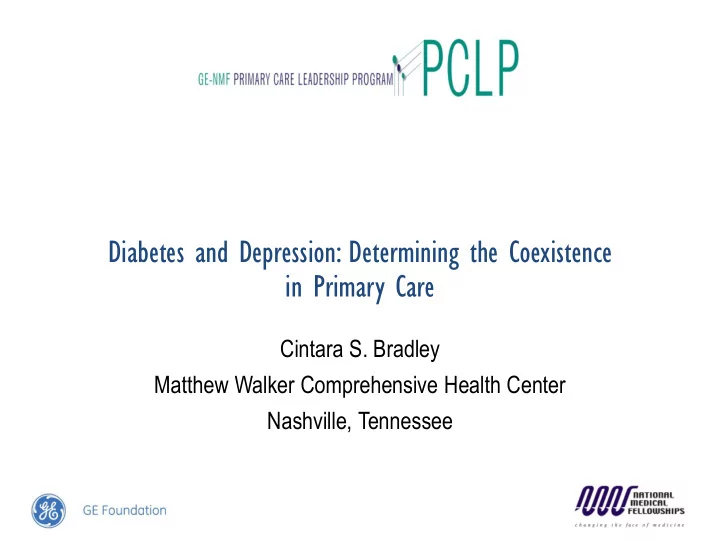

Diabetes and Depression: Determining the Coexistence in Primary Care Cintara S. Bradley Matthew Walker Comprehensive Health Center Nashville, Tennessee
Introduction • Overview • Background, Methods, Results, Discussion, Recommendations • Matthew Walker’s patient population • Largely African-American and Hispanic • What illnesses disproportionately affect these populations? • What are the risk factors associated with diabetes? • Barriers to effective treatment and management of disease
Background • Which ethnic groups are affected most by diabetes and depression? • 9% of African-Americans suffer with depression • 11.4% of Hispanics suffer with this disorder • African-Americans and Hispanics are also disproportionately affected by diabetes • Stigma associated with mental illness • Affects people who do not have insurance and who are between the ages of 45-64 • Some estimates show that diabetics are 2x more likely to suffer from depression. Largely untreated • How can we better address depression?
Methodology • Distributed the Patient Health Questionnaire-9 (PHQ-9) to both diabetic and non- diabetic patients. • Administered questionnaires from June 12 th through July 10 th . Follow-up interviews were conducted one month from each individual’s initial interview. • Questions asked about overall health and general wellbeing • Asked about depressive symptoms, including suicide attempts within the past two weeks • Educational information administered to diabetic patients • Blood pressure, weight, blood glucose readings, and number of comorbidities extracted from patients’ charts. • Follow-up within a month to determine if PHQ scores significantly differ after education about diet and exercise.
Results • Male non-diabetics had • Diabetics’ average PHQ score was significantly different from significantly higher PHQ non- diabetics’ at one -month scores than female non- follow-up (p=0.03). diabetics (p=0.0045). Average PHQ score of non-diabetics Average PHQ Score at Study's Inception and 7 at One-month Follow-up 6 8 5 7 4 6 5 Avg PHQ at Inception 3 4 2 3 Avg PHQ at one-month follow-up 2 1 1 0 0 Non-diabetic females Non-diabetic males Diabetics Non-diabetics
Results • Non-diabetic males had • Trend toward significance between PHQ scores non-diabetics with significantly higher PHQ triglyceride levels greater than scores than diabetic males 150mg/dL and non-diabetics with (p=0.038). triglyceride levels lower than 150mg/dL (p=0.097). Average PHQ score of diabetic and • Trend toward significance between non-diabetic males the PHQ scores of overweight non- diabetics and obese non-diabetic patients (p=0.096). 6 2.92 Diabetic males Non-diabetic males
Discussion • As expected, the number of comorbidities did significantly differ between groups, as well as the average fasting blood glucose levels. • Interesting that non-diabetics had a higher average PHQ in almost every comparison. • This could be attributed to the adult medicine physicians being able to properly treat and assist in managing the diabetic patients’ care, therefore effectively managing their depressive symptoms. • Research should be continued in order to monitor depressive states/symptoms of the entire patient population, including non-diabetics.
Recommendations • Begin administering the PHQ survey at all Matthew Walker sites. Though it should not be used in lieu of a diagnostic interview, this survey will help guide the physicians’ interview and assist them as they seek to provide more comprehensive care to their patient populations. • Provide education and treatment • Treating depression and other mental illnesses can help patients control their glycemic index. Literature shows that treating diabetes can facilitate mental and cognitive stability. • Education is key to properly managing any disease. Thus, properly educating patients will increase their awareness and possibly their willingness to better manage their illness(es). • Follow-up with patients to ensure they maintain good mental and physical health.
Conclusion • Screening for mental health disorders is necessary to provide quality care. • Administering the PHQ survey could help reduce stigma. • Administer the questionnaire to all patients regardless of age, gender, or illness because mental and physical health influence each other. • Encourage providers to advocate for improving and maintaining mental health. • Establish exercise classes to help both diabetic and non- diabetic patients reduce depressive symptoms without the emotional and financial burdens of medications.
Acknowledgements • General Electric-National Medical Fellowships Primary Care Leadership Program • Matthew Walker Comprehensive Health Center • Dr. Joyce Semenya, Family and Preventative Medicine • Dr. Williams, Medical Director • Mrs. Joy Banks and Mrs. Robin Dean • Matthew Walker support staff • Drs. Carol Freund and Dana Marshall
Recommend
More recommend